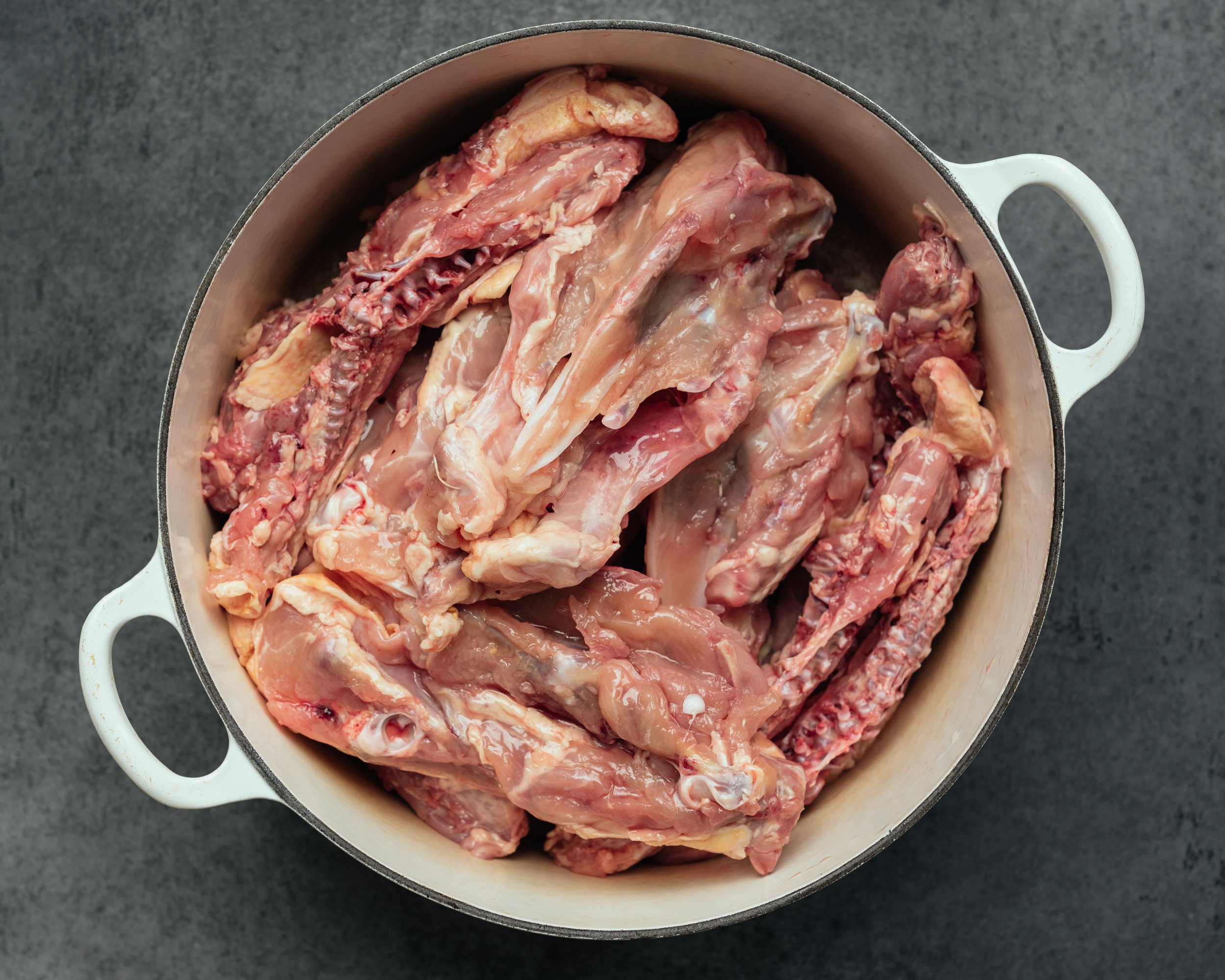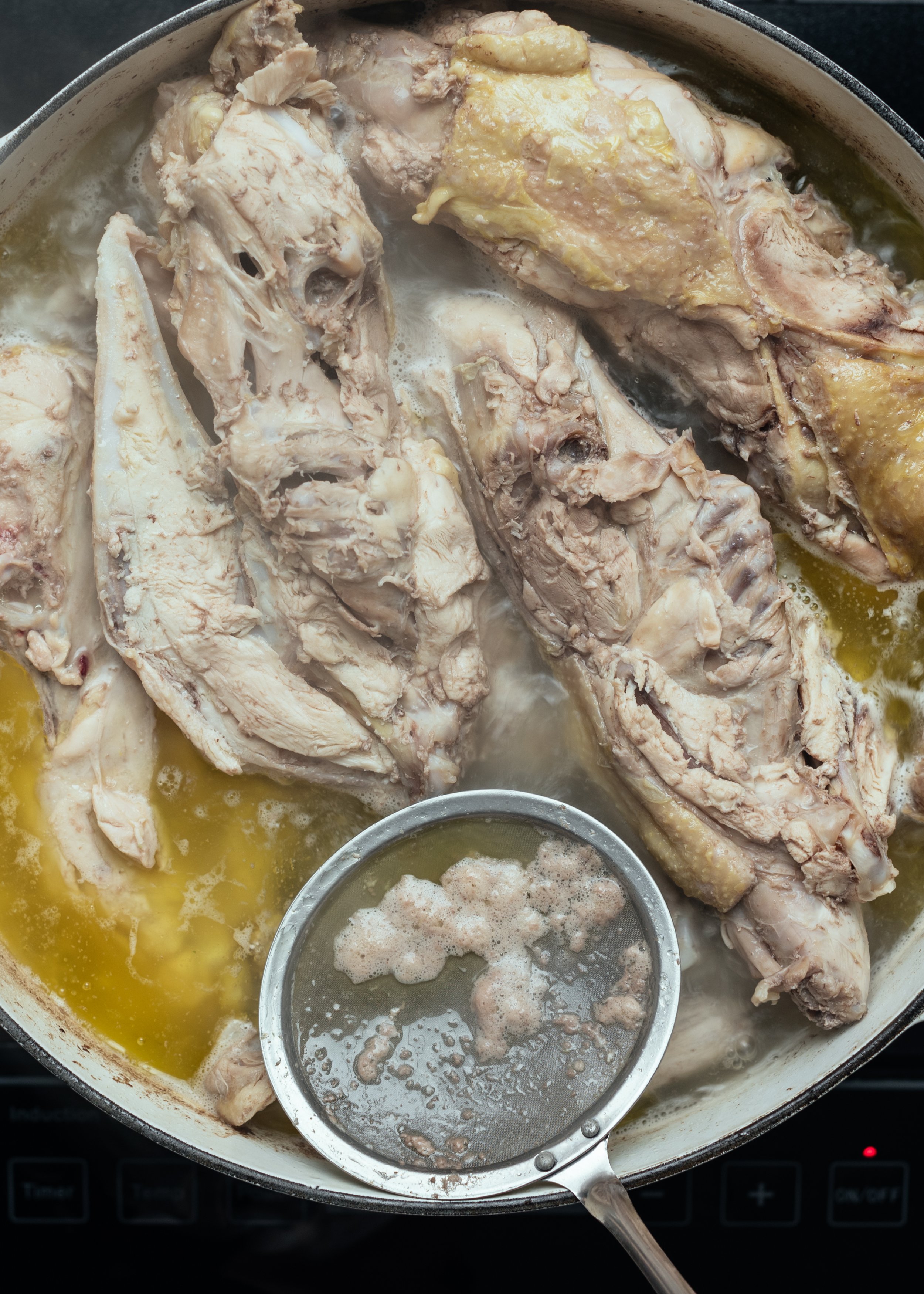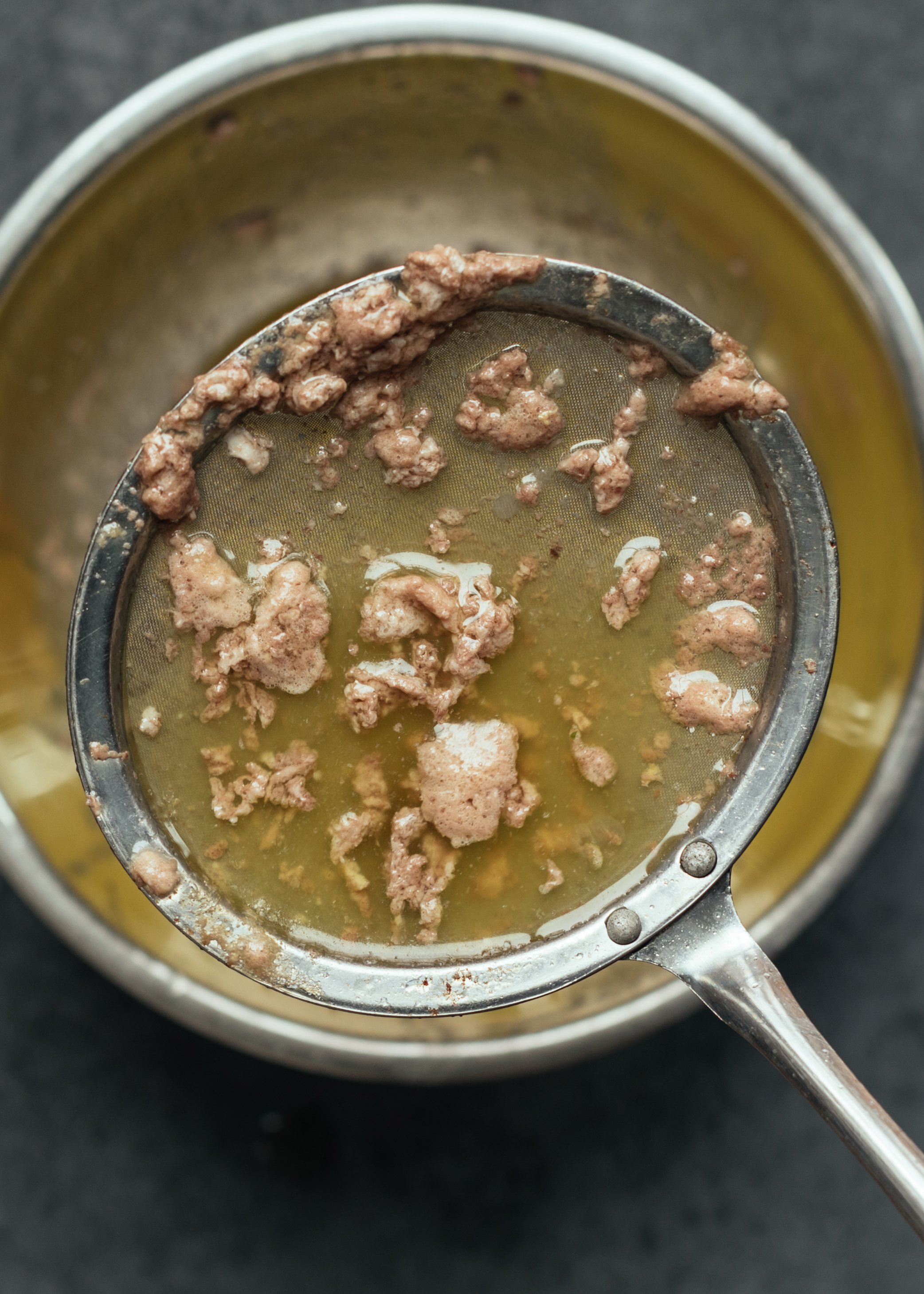How to make Bone Broth in the Oven
The proof is in the jello! I am sharing my favourite bone broth method to get bouncy bone broth jello every time…by cooking it in a SUPER LOW OVEN 🤯
For chicken bone broth (my go-to), I use parts like chicken backs, necks, carcasses, wings and/or leg bones from a butcher AND/OR bones saved from home cooked meals. What about chicken feet? I’ll leave that up to you! I’m used to eating chicken feet at dim sum but I get that some people may get the yuck from them. Plus they are simply harder to get for most people. That said if you do come across them, don’t hesitate to use them because they are the most collagen-rich chicken part if you’re keen on that bone broth jello! (For my local readers, Galleria Korean supermarket sells them in frozen packs).
This Oven Bone Broth Recipe is your ticket to gelatinous glory and deeply savoury, flavourful broth to sip or create meals with.
I’ve been making bone broth for many, many years using the stove top or my Instant Pot, and didn’t always get very firm jello. In the controlled, super-low temperature of the oven, I never risk over boiling thus melting the collagen. For some reason, cooking bone broth in the oven isn’t at least as popular as the other methods (i.e. stove top, pressure cooker, slow cooker) which really surprises me!?! This method for Oven Bone Broth has been fail proof for me and I am confident it will be the same for you.
Please read through my Tips and FAQs below before starting and as always, let me know if you have any questions in the comment section. Check out my video below to see that glorious bone broth jiggle 🤩
Eat well and be well,
Sonia x
🎥 Watch video for Oven Bone Broth Recipe
Steps at a glance:
How to make Bone Broth in the Oven (scroll down for full recipe card):
Place bones in a large Dutch oven or heavy-lidded pot. This time in particular, I had raw carcass, backs, necks. Plus after the photo was taken, I remembered and added saved cooked leg bones from the freezer. See Tips and FAQs for more about types of bones to use.
Rid the bones of scum and impurities. I offer two different methods of doing this. See instructions for each option in the recipe card
Option 1: Soak, boil, skim
Option 2 (my preferred): Boil, dump out, add fresh water
Once the scum is cleared using one of the two methods, we add vegetables, garlic, vinegar (if using) and water to the bones, bring it all to a rolling boil, and the pot is ready to head for a long snooze in the 150°F (65°C) oven.
Cover and place the pot in the 150°F (65°C) oven. If you’re wondering about the food safety of cooking chicken bone broth at 150°F when the universally accepted temperature of cooked chicken is known to be 165°F, read the Tips and FAQs section below. It is safe!
Cook for anywhere between 12 to 18 hours in the oven (I’ve even left it up to 24 hours), whenever it’s convenient to deal with straining and storing.
Strain over fine-mesh colander (or colander layered with cheesecloth) to catch any small bone bits.
This bone broth is pretty concentrated. I prefer making it this way as it takes up less storage room in the freezer/fridge. Dilute with water to drink or use in recipes as desired.
Tips and FAQs for Oven Bone Broth Recipe
What is bone broth?
Bone broth is a clear, protein-dense liquid made by simmering animal bones and connective tissues such as cartilage from any animal such as chicken, beef or pork in water often along with vegetable and aromatics at a very low temperature for an extended amount of time. To me, making bone broth is a no-brainer since it is (a) nutritious (b) soothing and deeply flavourful and (c) is made with cheap (or free!) bones.
Is bone broth healthy?
The belief is that this ‘low and slow’ process described above extracts the collagen out of the bones and cartilage. Collagen is a protein that is rich in the amino acids glycine and proline. When collagen-rich foods are ingested, the collagen breaks down in the stomach into the amino acids to be used by the body as building blocks to make a variety of proteins including collagen. Collagen has been shown to improve elasticity and moisture in the skin, sooth gut irritation and inflammation, and improve overall joint and bone health. Bone broth is also a good source of the amino acid glutamine, which is notably important for maintaining gut barrier function. A “leaky gut” is one where the barrier “leaks” things like microorganisms, fungi, food proteins and toxins into the bloodstream, leading to inflammation and an immune response. All that said, while there is clinical evidence of the foregoing benefits of collagen, glycine, proline and glutamine, there is a lack of direct human clinical research of bone broth itself (source: Canadian digestive Health Foundation cdhf.ca). Some experts question if stomach acids break down those amino acids before they have a chance to be used by the body at all. Therefore, I take all of this with a grain of salt, and focus more on the other benefits of making bone broth which is that it is a good source of protein, it is really flavourful and so soothing to drink, and it is cheap to make at home. Any collagen / skin / hair benefits being a definite upside :)
Why do I care if my bone broth gels?
Apart from it’s superb flavour, bone broth is probably most prized for the presence of the protein gelatin. Gelatin is the cooked form of collagen, in this case, when bones and cartilage are simmered over a long period at a low enough heat to not completely break down the collagen. When consumed, gelatin has been associated with promoting gut health, supporting the immune system by protecting the lining of the small intestines, supporting joint health and improving the appearance of skin, hair and nails. A bone broth that solidifies like jello (gels) once chilled in the fridge indicates the presence of gelatin, hence why we love to see it!
How is bone broth different from stock? Or regular broth?
Actually, bone broth is indeed a stock. The traditional definition of stock is a liquid made by simmering animal bones (with or without meat), vegetables and aromatics for 2-4 hours on the stove. Bone broth specifically does not contain any meat (although often there may be bits of meat attached to the bones) and is cooked over a longer period of time. Both “stock” and “bone broth” yield liquids that gels when chilled because of the presence of gelatin. Regular “broth” is made by simmering meat (with or without bones) with vegetables and aromatics in a shorter amount of time, i.e less than 2 hours, and does not gel when chilled. (sources: bonappetit, thekitchn)
Why bother making bone broth at home?
It wasn't until I started making it myself that I realized how much more amazingly flavorful my own broth is. So much better than any store-bought broth I have access to. Store bought, high quality bone broth is super convenient but quite pricey! Not to mention, can be high in sodium. It is cheap to buy bones ($2-3/lb depending type of bone) or basically FREE if you, like me, collect every bone from every meal for bone broth. Keep it all in a freezer bag until you have enough or feel like making some.
Is it safe to make chicken bone broth at 150°F?
We need heat to extract collagen from bones and connective tissues. Collagen begins to melt at 160°F and fully dissolves at 180°F. That’s why a low heat is required for bone broth to gel. Extended exposure to a too-high temperature may destroy the collagen thus preventing bone broth from gelling. I set my oven to cook at 150°F, which is my lowest oven setting. I know people will question using an oven temperature of 150°F for chicken bone broth, when the guideline for doneness is 165°F for chicken. Let me assure you, I have done my research and it is safe. Here is an excellent explanation from Thermoworks.com (the maker of Thermapen):
“most people know about 165°F (74°C), but what most people don’t know is that food safety (bacterial die-off) is a function of both temperature and time. You can achieve the exact same bacterial death by holding your chicken at lower temperatures for longer times with the exact same assurance of safety. The USDA provides guidelines for industry on food safety…to indicate how long it takes to kill enough bacteria at a given temperature.”
Based on the chart, the time needed for bacterial die-off in medium-lean chicken at 150°F (65°C) is 3 minutes. JUST 3 MINUTES. Since we are cooking this chicken bone broth for 12-18 hours, it is fair to conclude that this recipe is perfectly safe.
Why make bone broth in the oven?
✔︎ Maintaining a low heat is important for extracting collagen out of the bones without melting it. Cooking in the temperature-controlled environment of the oven gives me peace of mind that I won’t accidentally over boil and melt the collagen. ✔︎ Ideal for people who feel apprehensive leaving the stove top on overnight, especially gas burners. A closed-off oven feels safer to me and I don’t need to run the fume hood the whole time either. ✔︎ While my Instant Pot is faster, the super low and slow oven approach gives me more flexibility to deal with the straining / storing whenever convenient because I can leave it in the oven anywhere between 12 to 18 hours. ✔︎ My big Dutch oven fits more than my Instant Pot, another plus.
Types of bones to use
The truth is, how gelatinous your broth gets does depend on the mix bones used. When purchasing bones from the butcher, don't shy away from the collagen-rich parts like wings, necks and feet for chicken broth and marrow bones, knuckles and ox tail for beef broth. These are going to yield the most gelatinous broth. When I’m using bones saved from a meal, it tends to be leg bones which are great too especially in combination with those other parts listed.
Save bones from home cooked meals
Don’t throw them away. Once the meat is pulled off and enjoyed, toss the bones into a freezer bag and freeze until there’s enough or you feel in the mood to make a batch of broth. Rinse the bones if there is a lot of sauce on them, depending on how they were cooked. Usually I mix these saved bones with fresh bones purchased at the butcher. Sometimes, my entire broth is made from saved cooked bones if that’s all I have.
Add less water to start
If you’re keen on getting highly-gelatinous bone broth, err on the side of adding less water to the pot. Fill it up to an inch below the bones. I do this when I don’t have super collagen-rich bone pieces. Also, highly concentrated broth takes up less room to store or freeze. You can easily dilute with water later for drinking or for use in recipes.
Rid the scum for clear broth
When boiling the bones, proteins and fats foam and floats to the surface. Skim this off in the first 5 minutes of boiling. Doing so will yield cleaner broth.
Is it necessary to roast the bones?
Many bone broth recipes call for roasting raw bones in a 400°F oven until they get brown to extract more flavor. I don’t do this but you can if you want!
Why is apple cider vinegar listed as optional?
People swear by the addition of acid in bone broth to extract minerals such as calcium from the bones. However, studies (including one conducted by USDA) have shown bone broths contain low levels of vitamins and minerals, much of which is derived from the vegetables rather than the bones. I’ll leave it up to you to add or not but you can’t taste it in the final broth, so it doesn’t hurt to add it!
Use a fine-mesh strainer
Especially for chicken bone broth, there may be small bone bits that need to be strained off. Use a colander with a very fine mesh (see photo in blog post) or place three layers of cheesecloth on a colander to strain.
Now that I’ve answered some questions that you may have had, find my recipe below!
Notes for Oven Bone Broth Recipe
Freezing:
I don’t do canning so my go-to storage method is to freeze my broth in glass jars. Make sure to leave a good amount of head space or else it may explode as the air inside expands during freezing! I aim for about 1” head room on straight jars or just under where the glass begins to curve inward on a mason jar, no higher. I have wept over cracked containers and wasted broth. Silicon ice cube trays with large compartments are fantastic too for an assortment of smaller frozen portions to use in sauces etc.
Defrosting:
When defrosting in glass jars, avoid huge swings in temperature. Even tempered glass jars can sometimes crack under temperature stress so it is safest to defrost gradually, preferably overnight in the fridge or defrost slowly in the microwave.
You may also be interested in this related post:
How to make Bone Broth in the Oven
Recipe makes about 10 cups of concentrated bone broth. Dilute broth with water as desired to drink or use in recipes. If you’re wondering about the food safety of cooking this chicken bone broth at 150°F, read the info under FAQs (it is safe).
We love homemade bone broth with wontons or noodles.
Do you have trouble getting your bone broth to gel? Do you have any bone broth tips to share with me? If you tried my oven method, let me know how it went in the comments!














